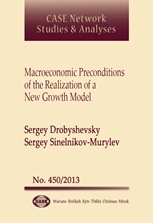Study "Macroeconomic Preconditions of the Realization of a New Growth Model" released
 “Russia entered the 2007-2009 global economic crisis with good macroeconomic indicators: in 2000-2008, its average annual real GDP growth rate was 7%, the federal budget surplus rose to 7% of GDP, its government debt was less than 15% of GDP, and its banking and financial sectors were rapidly developing,” state Sergey Drobyshevsky and Sergey Sinelnikov-Murylev, the authors of the newly-published paper in the CASE Studies and Analysis series. “However,” they continue, “over the entire 2000-2010 decade, the Russian economy faced growing internal problems temporarily camouflaged by the high revenues resulting from a very favorable situation on external raw materials markets.”
“Russia entered the 2007-2009 global economic crisis with good macroeconomic indicators: in 2000-2008, its average annual real GDP growth rate was 7%, the federal budget surplus rose to 7% of GDP, its government debt was less than 15% of GDP, and its banking and financial sectors were rapidly developing,” state Sergey Drobyshevsky and Sergey Sinelnikov-Murylev, the authors of the newly-published paper in the CASE Studies and Analysis series. “However,” they continue, “over the entire 2000-2010 decade, the Russian economy faced growing internal problems temporarily camouflaged by the high revenues resulting from a very favorable situation on external raw materials markets.”
According to the authors, the economic growth model developed in the early 2000s cannot answer the current challenges faced by the Russian economy; hence, the Government has adopted the new approach, the so-called “Strategy-2020”. Developed in 2011 by the expert community, “Strategy-2020” offers a new model of economic growth based on the promotion of macroeconomic stability, the de-stratification of the economy, and a social policy oriented towards increasing the level of human capital development. In their paper, Sergey Drobyshevsky and Sergey Sinelnikov-Murylev discuss the appropriate conditions that need to be created so that “Strategy-2020” may be implemented successfully.
Click here to access the publication.
